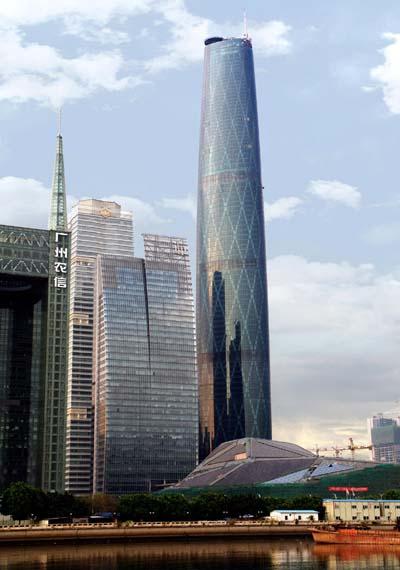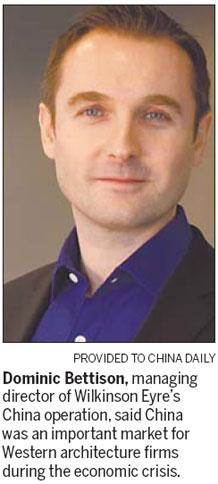
The 440-meter Guangzhou International Finance Center which is set to be completed later this year. Architects Wilkinson Eyre of London designed the skyscraper. [China Daily]
Western firms influencing new approach to modern design
BEIJING: Dominic Bettison says China has been an important market for Western architecture firms during the economic crisis.
The 41-year-old is managing director of leading international architects Wilkinson Eyre's China operations.
The firm, headquartered in London, is the designer of the 440-meter high Guangzhou International Finance Center set to be completed later this year.
The 2.8 billion yuan project for the Yuexie Group has 103 floors and will be one of China's tallest buildings. It will mark Guangzhou's hosting of the Asia Games.
"I think China has been a very robust market during the economic troubles the rest of the world has had, " he said.
"It is not true to say it has been totally unaffected. I think there has been a certain caution in the market but there is still certainly money available for construction projects."
Bettison, who is based in London but travels to China twice a month, said the speed with which buildings can be designed and built is one of the most exhilarating aspects of working in the country.
"It can take double the time to build something in London, for example. You also face the high risk of not getting planning permission, particularly for a tall building," he said.
"London is, of course, a much denser, more tightly packed city. In China new buildings go up in new parts of the city, sometimes in new business districts that are started from scratch."
The Guangzhou International Finance Center project was awarded to Wilkinson Eyre, which had a design team in Hong Kong working on it, in 2006.
Initial construction began later that year and it was topped out in December 2008. With a Four Seasons Hotel on the top, the building in Zhujiang Avenue West in Tianhe District will have some of the highest living space in the world.
"In terms of having the highest occupied floor space we are up there with the top three or four buildings in the world," added Bettison.
Wilkinson Eyre, which already has one international office in Singapore, is planning to open one in Shanghai later this year and is currently awaiting approval.
It also has a dedicated China team of 20 in its London office, many of who are Chinese speakers, out of a total staff of around 130.
"This really reflects the amount of business coming through from China. It is a very reliable stream of opportunity," he said.
"We are trying to select projects which we think are best suited to our skills, provide the best opportunities and, I suppose, are the most high profile."
Bettison, who joined Wilkinson Eyre in 1991 and has worked extensively in the Far East, said working in China was a good opportunity for any architectural firm to try out new techniques and materials.
"The Chinese are very forward looking. They want modern designs. They are very comfortable with the modern approach to planning a building so we never run into issues like contextualism or the retention of anything historic," he said.
"It is very much a blank sheet of paper to produce a building which suits them down to a very precise point where there really is no need for any compromises at all."
"They are also very happy to embrace new technologies such as how to build something tall or to make it more energy efficient."
Bettison, who is an expert on tall buildings and spoke at the third Annual Tall Buildings Conference in Shanghai last year, said there have been problems with the quality of construction in China and standards still need to improve so that buildings do not only have state-of the art design but build-quality as well.
"I think in some areas this is still a concern for Western architects. Construction historically in China has always been something that has needed to catch up," he said.

"A lot of key buildings have been designed by foreign firms with a level of knowledge and expertise and it has taken a little while for contractors to catch up and implement those designs. The quality of the buildings needs to match the quality of the design."
Wilkinson Eyre is currently working on a number of high residential and commercial developments around China and also a new interchange subway station in Beijing in conjunction with a local design institute.
"We act as a consultant on transport projects in Europe and across the world and we have a fantastic opportunity now in China to design a landmark station, a real facility for the people."
Bettison admits the economic crisis has led to a number of projects being shelved or canceled altogether in the United States and Europe as a result of the economic downturn.
"A lot of our commercial clients decided to put projects on hold and I think that is true of pretty much all other practices I know," he said.
"Architecture firms can lose up to 70 per cent of their revenue of a project if it does not proceed through the planning stage."
He said, however, that the picture in the West is not altogether bleak and that there are signs of life returning to the market.
"We are starting to see green shoots from a number of UK developers and we can start to move forward but it does not mean to say the same budgets are available as was the case at the height of the boom."
Meanwhile, such frugality is not quite the watchword in China with the momentum of construction if anything intensified by the country's stimulus package.
Bettison said China is becoming the main focus of architectural firms around the world.
"We certainly see it that way. The country will probably become the world's largest economy some time this century and it can only be a market of immense opportunity for western firms. We certainly see it very positively," he said.





